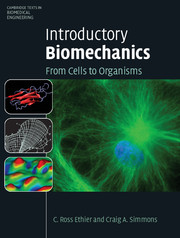Book contents
- Frontmatter
- Contents
- About the cover
- Preface
- 1 Introduction
- 2 Cellular biomechanics
- 3 Hemodynamics
- 4 The circulatory system
- 5 The interstitium
- 6 Ocular biomechanics
- 7 The respiratory system
- 8 Muscles and movement
- 9 Skeletal biomechanics
- 10 Terrestrial locomotion
- Appendix: The electrocardiogram
- Index
- Plate section
- References
4 - The circulatory system
Published online by Cambridge University Press: 05 June 2012
- Frontmatter
- Contents
- About the cover
- Preface
- 1 Introduction
- 2 Cellular biomechanics
- 3 Hemodynamics
- 4 The circulatory system
- 5 The interstitium
- 6 Ocular biomechanics
- 7 The respiratory system
- 8 Muscles and movement
- 9 Skeletal biomechanics
- 10 Terrestrial locomotion
- Appendix: The electrocardiogram
- Index
- Plate section
- References
Summary
We now turn our attention to the system that transports the blood: the heart and blood vessels. From an engineering viewpoint, the circulatory system consists of a remarkably complex branching network of tubes that convey the blood (the vasculature; Fig. 4.1), and two pulsatile pumps in series to force the blood through the tubes (the heart). The vasculature consists of arteries, arterioles, capillaries, venules, and veins. On average, no cell in the body is more than approximately 40 μm away from a capillary, and almost every tissue is thoroughly invested with a capillary network. A typical human contains approximately 5 liters of blood, and at rest the heart pumps approximately 6l/min; consequently, on average, blood circulates throughout the body about once per minute. In this chapter, we emphasize the operation of the components of the circulatory system, how they interact with one another, and how they work in concert to deliver blood to target tissues.
Anatomy of the vasculature
For reasons to be described below, it is conventional to divide the vasculature into two parts: the pulmonary and systemic circulations. The loop from the right heart, through the lungs, and back to the left heart is known as the pulmonary circulation; the loop from the left heart to the body and back to the right heart is the systemic circulation. Both the pulmonary and systemic vasculature have a similar topology.
- Type
- Chapter
- Information
- Introductory BiomechanicsFrom Cells to Organisms, pp. 164 - 239Publisher: Cambridge University PressPrint publication year: 2007
References
- 1
- Cited by



